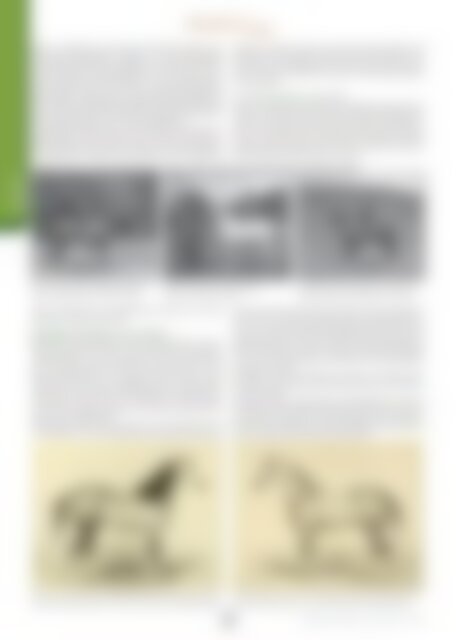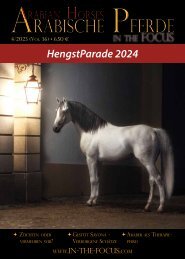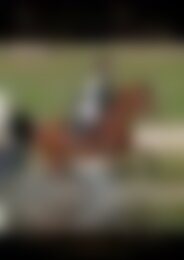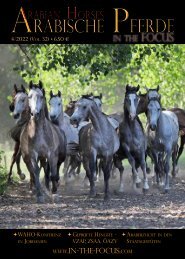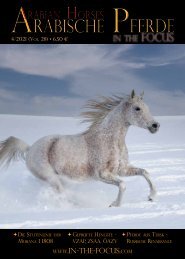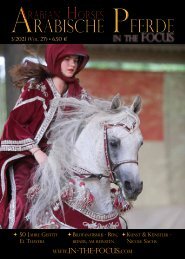Arabische Pferde IN THE FOCUS 1/2023 (Vol. 33) - public
Zeitschrift für Liebhaber und Züchter arabischer Pferde
Zeitschrift für Liebhaber und Züchter arabischer Pferde
Sie wollen auch ein ePaper? Erhöhen Sie die Reichweite Ihrer Titel.
YUMPU macht aus Druck-PDFs automatisch weboptimierte ePaper, die Google liebt.
Araber in beträchtlicher Zahl widmete. Diese <strong>Pferde</strong> galten als den<br />
importierten Wüstenpferden überlegen. Zu den Gründerpferden<br />
in Ahmednagar gehörten zwei Hengste aus Crabbet Park: Mareukh<br />
(Mesaoud / Nefisa) und Rashid (Mesaoud / Rose of Sharon), zusammen<br />
mit anderen von den Rennbahnen in Poona und Bombay. Einer<br />
dieser Hengste, Silver Thrush, *1921, ein in der Wüste gezüchteter<br />
Hengst, Sieger in 9 Rennen, galt als außergewöhnlich mit großer Substanz,<br />
Schönheit und Qualität. Er deckte eine in der Wüste gezüchtete<br />
Stute, Amsha, ebenfalls aus Ahmednagar, das Ergebnis war ein Stutfohlen,<br />
Nightingale, die noch eine Linie in Südafrika hat.<br />
Heutzutage ist es Pakistan, das noch eine Remonte-Zucht in Mona im<br />
Punjab betreibt, auf einem Stück Land, das 1902 der damaligen Regierung<br />
zugesprochen wurde. Das Gestüt in Mona wurde ursprünglich<br />
gegründet, um Maultiere für die Artillerie und den allgemeinen<br />
Nowadays it is Pakistan that carries on Remount breeding at Mona in the<br />
Punjab, on some land granted in 1902 to the Government of the time. The<br />
stud in Mona was originally formed to breed mules for artillery and general<br />
service work, but Arabian horses have successfully been bred there<br />
for many decades.<br />
<strong>THE</strong> OTTOMAN EMPIRE AND TURKEY<br />
During the 19th Century as the Empire was slowly dying, there was a period<br />
when the Sultans cared less for horses and “Royal” breeding almost<br />
came to a stop. However, the last Ottoman Emperor, Sultan Abdul Hameed<br />
II, was fond of horses and maintained a particularly fine collection.<br />
He was in a singular position to acquire the best with all the main tribal<br />
breeding areas still under Ottoman rule, and it would have been impossible<br />
to refuse to part with any horse he required.<br />
<strong>Pferde</strong> im Gestüt von Sultan Abdul Hamid II, Fotos ca. 1880 - 1893 - Horses at the Stud of Sultan Abdul Hameed II<br />
Zucht<br />
Derya, Araberhengst, Dunkelfuchs, Kuheyli<br />
Derya, Arabian stallion, chestnut, Kuheyli<br />
Bedevy, arabischer Schimmelhengst<br />
Bedevy, grey Arabian stallion<br />
Chedide, brauner Araberhengst vom Stamm<br />
Saklavy; bai Arabian stallion, strain Saklavy.<br />
Dienst zu stellen, aber auch Araberpferde werden dort seit vielen<br />
Jahrzehnten erfolgreich gezüchtet.<br />
DAS OSMANISCHE REICH UND DIE TÜRKEI<br />
Während des 19. Jahrhunderts, als das Osmanische Reich langsam<br />
zu Ende ging, gab es eine Zeit, in der sich die Sultane weniger um<br />
<strong>Pferde</strong> kümmerten und die „königliche“ Zucht fast zum Erliegen<br />
kam. Der letzte osmanische Kaiser, Sultan Abdul Hamid II., war<br />
jedoch pferdebegeistert und unterhielt eine besonders schöne<br />
Sammlung. Er war in einer einzigartigen Position, um das Beste zu<br />
erwerben, da alle wichtigen Stammesgebiete der pferdezüchtenden<br />
Beduinen immer noch unter osmanischer Herrschaft standen,<br />
und es wäre unmöglich gewesen, sich nicht von einem Pferd zu<br />
trennen, das er haben wollte.<br />
Als Amerikas General Grant den Sultan auf seiner großen Weltreise<br />
1877 besuchte, war er sehr beeindruckt vom Stall des Sultans, voll<br />
When America’s General Grant visited the Sultan on his great world tour<br />
of 1877 he was very impressed with the Sultan’s stable of purebred Arabian<br />
horses. The story goes that the flattered Sultan allowed him to pick<br />
out any two stallions he desired and take them back to USA. He chose a<br />
"dappled gray" and an "iron gray", which were eventually shipped back to<br />
New York. They became known as Leopard and Linden Tree and appear<br />
in <strong>Vol</strong>. 2 of the American Registry. Leopard has pure bred descendants<br />
through his son Anazeh.<br />
The Sultan’s horses also participated successfully in the 1900 Paris World<br />
Exhibition winning with their black stallion Suveyme and coming 2nd<br />
with a mare Seklavi.<br />
The Ottoman Empire officially ended in 1922 followed by the creation of<br />
the Re<strong>public</strong> of Turkey under Marshal Mustafa Kemal Ataturk. In 1925 on<br />
his instruction the registration and breeding of horses was restarted under<br />
State control. Large State studs were established, and many stallion<br />
stations created for the improvement of local breeds.<br />
Linden Tree, Araberhengst *1874 aus dem Gestüt Sultan Abdul Hamid II<br />
Linden Tree, Arabian stallion *1874, from the stud of S. Abdul Hameed II.<br />
Leopard, Araberhengst *1873, aus dem Gestüt Sultan Abdul Hamid II.<br />
Leopard, Arabian stallion *1873, from the stud of S. Abdul Hameed II.<br />
30<br />
© ARABISCHE PFERDE - <strong>IN</strong> <strong>THE</strong> <strong>FOCUS</strong> 1/<strong>2023</strong>


